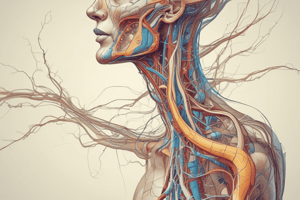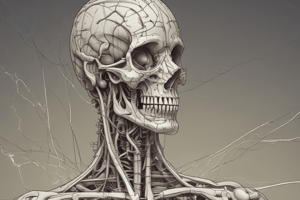Podcast
Questions and Answers
What are the two subdivisions of the Autonomic Nervous System (ANS)?
What are the two subdivisions of the Autonomic Nervous System (ANS)?
- Central nervous system (CNS) and Peripheral nervous system (PNS)
- Somatic nervous system (SoNS) and Enteric nervous system (ENS)
- Motor nervous system (MNS) and Sensory nervous system (SNS)
- Sympathetic nervous system (SyNS) and Parasympathetic nervous system (PsyNS) (correct)
How does the Autonomic Nervous System (ANS) differ from the Somatic Nervous System (SoNS) anatomically?
How does the Autonomic Nervous System (ANS) differ from the Somatic Nervous System (SoNS) anatomically?
- The ANS synapses directly onto effectors, while the SoNS controls effectors via a two neuron chain.
- The ANS and SoNS both control effectors via a two neuron chain.
- The ANS and SoNS both synapse directly onto effectors in the CNS.
- The ANS controls effectors via a two neuron chain, while the SoNS synapses directly onto effectors. (correct)
Which nervous system predominates during resting conditions, often referred to as 'rest & digest'?
Which nervous system predominates during resting conditions, often referred to as 'rest & digest'?
- Parasympathetic nervous system (PsyNS) (correct)
- Sympathetic nervous system (SyNS)
- Somatic nervous system (SoNS)
- Enteric nervous system (ENS)
In a given system, what is the usual relationship between the sympathetic and parasympathetic divisions of the Autonomic Nervous System (ANS)?
In a given system, what is the usual relationship between the sympathetic and parasympathetic divisions of the Autonomic Nervous System (ANS)?
What is the range of sound waves that the human auditory system responds to?
What is the range of sound waves that the human auditory system responds to?
What is the anatomical basis of referred pain?
What is the anatomical basis of referred pain?
How is the intensity of sound measured?
How is the intensity of sound measured?
What determines the pitch of sound perceived by the auditory system?
What determines the pitch of sound perceived by the auditory system?
Which division includes preganglionic neurons in brainstem cranial nerve nuclei and IML cell column?
Which division includes preganglionic neurons in brainstem cranial nerve nuclei and IML cell column?
What is the speed of sound through air?
What is the speed of sound through air?
What do autonomic afferents from organs generally follow?
What do autonomic afferents from organs generally follow?
What causes visceral pain?
What causes visceral pain?
Which division innervates organs including the eye, salivary glands, and kidneys?
Which division innervates organs including the eye, salivary glands, and kidneys?
What is the range of infrasound?
What is the range of infrasound?
What is the range of ultrasound?
What is the range of ultrasound?
What is the perceived effect of a ten-fold increase in sound intensity?
What is the perceived effect of a ten-fold increase in sound intensity?
What is responsible for processing sound and is structured with the oval window at the base of the scala vestibuli and the round window at the base of the scala tympani?
What is responsible for processing sound and is structured with the oval window at the base of the scala vestibuli and the round window at the base of the scala tympani?
What detects the static position and linear acceleration of the head within the otolith organs?
What detects the static position and linear acceleration of the head within the otolith organs?
Which type of deafness involves the inner ear or cochlear nerve?
Which type of deafness involves the inner ear or cochlear nerve?
What causes pressure waves in the scala vestibule, which are relieved at the round window?
What causes pressure waves in the scala vestibule, which are relieved at the round window?
Which part of the inner ear includes the cochlea, vestibule, and semicircular canals?
Which part of the inner ear includes the cochlea, vestibule, and semicircular canals?
What is tonotopically organized, with specific frequencies activating specific populations of neurons in the spiral organ?
What is tonotopically organized, with specific frequencies activating specific populations of neurons in the spiral organ?
Which part of the auditory pathways have clinical implications for unilateral lesions?
Which part of the auditory pathways have clinical implications for unilateral lesions?
What detects head rotation and is arranged at right angles to each other?
What detects head rotation and is arranged at right angles to each other?
What detects the equilibrium sensations and processes pathways to coordinate head movement with eye, neck, trunk, and limb movement?
What detects the equilibrium sensations and processes pathways to coordinate head movement with eye, neck, trunk, and limb movement?
What causes bursts of action potentials in afferent neurons?
What causes bursts of action potentials in afferent neurons?
What is responsible for the pulsatile release of neurotransmitters from hair cells?
What is responsible for the pulsatile release of neurotransmitters from hair cells?
Which part of the inner ear comprises the sense organs for hearing and balance?
Which part of the inner ear comprises the sense organs for hearing and balance?
Which part of the ear gathers sound waves?
Which part of the ear gathers sound waves?
What is the function of the external auditory canal and middle ear?
What is the function of the external auditory canal and middle ear?
What is the main function of the cochlea?
What is the main function of the cochlea?
Where are the hair cells and support cells that transduce sound energy located?
Where are the hair cells and support cells that transduce sound energy located?
What initiates pressure waves in the inner ear?
What initiates pressure waves in the inner ear?
What is the role of the vestibulocochlear nerve (CN VIII) in the ear?
What is the role of the vestibulocochlear nerve (CN VIII) in the ear?
Where is the membranous labyrinth located?
Where is the membranous labyrinth located?
What is the function of the tympanic cavity in the middle ear?
What is the function of the tympanic cavity in the middle ear?
What is the main function of the auditory ossicles?
What is the main function of the auditory ossicles?
What is the role of the bony labyrinth in the inner ear?
What is the role of the bony labyrinth in the inner ear?
What is the function of the vestibular apparatus in the inner ear?
What is the function of the vestibular apparatus in the inner ear?
What is the main role of the spiral organ in the cochlea?
What is the main role of the spiral organ in the cochlea?
Where are the preganglionic neurons of the Sympathetic Nervous System (SyNS) located?
Where are the preganglionic neurons of the Sympathetic Nervous System (SyNS) located?
Which part of the nervous system targets the smooth muscle of limbs and body wall?
Which part of the nervous system targets the smooth muscle of limbs and body wall?
Where are the postganglionic sympathetic neurons located that innervate the body wall and limbs?
Where are the postganglionic sympathetic neurons located that innervate the body wall and limbs?
Which part of the nervous system decreases heart rate?
Which part of the nervous system decreases heart rate?
Where are the preganglionic neurons of the Parasympathetic Nervous System (PSyNS) located?
Where are the preganglionic neurons of the Parasympathetic Nervous System (PSyNS) located?
Which part of the nervous system innervates the thoracic viscera?
Which part of the nervous system innervates the thoracic viscera?
Where are the postganglionic sympathetic neurons located that innervate the abdominopelvic viscera?
Where are the postganglionic sympathetic neurons located that innervate the abdominopelvic viscera?
What does the Adrenal Medulla release when stimulated by preganglionic sympathetic neurons?
What does the Adrenal Medulla release when stimulated by preganglionic sympathetic neurons?
Which type of neurons innervate skeletal muscle?
Which type of neurons innervate skeletal muscle?
Where do preganglionic sympathetic fibers distribute sympathetics to dermatomes above T1 and below L2?
Where do preganglionic sympathetic fibers distribute sympathetics to dermatomes above T1 and below L2?
Which part of the nervous system is responsible for monitoring skin, joints, and skeletal muscle?
Which part of the nervous system is responsible for monitoring skin, joints, and skeletal muscle?
Flashcards are hidden until you start studying
Study Notes
Summary: Anatomy and Function of the Sympathetic Nervous System
- The Sympathetic Nervous System (SyNS) increases heart rate, while the Parasympathetic Nervous System (PSyNS) decreases heart rate, and they occasionally work independently.
- The two divisions, SyNS and PSyNS, differ anatomically in the locations of their preganglionic neuron, autonomic ganglion, and postganglionic neuron.
- The spinal grey matter is organized into continuous columns extending the length of the cord, comprising gray matter and white matter, with ventral roots at all levels and divided into spinal nerve, dorsal root ganglion, dorsal root, dorsal horns, and ventral horns.
- The Sympathetic Division targets smooth muscle of limbs and body wall, viscera of head and thorax, and viscera of abdomen and pelvis.
- Somatic motor neurons innervate skeletal muscle, while sensory neurons monitor skin, joints, and skeletal muscle.
- The body wall and limbs are innervated by postganglionic sympathetic neurons located in the paravertebral or sympathetic chain ganglia.
- Preganglionic sympathetic fibers can ascend or descend within the sympathetic chain before synapsing, distributing sympathetics to dermatomes above T1 and below L2.
- The Sympathetic Nervous System innervates thoracic viscera and targets in the face through postganglionic sympathetic neurons located in the paravertebral or sympathetic chain ganglia.
- Abdominopelvic viscera are innervated by postganglionic sympathetic neurons located in the prevertebral ganglia, such as the celiac, superior mesenteric, and inferior mesenteric ganglia.
- The Adrenal Medulla, a modified sympathetic ganglion, is innervated by preganglionic sympathetic neurons of the lateral gray horns and releases epinephrine and norepinephrine, which is picked up by blood vessels for systemic distribution.
Studying That Suits You
Use AI to generate personalized quizzes and flashcards to suit your learning preferences.




